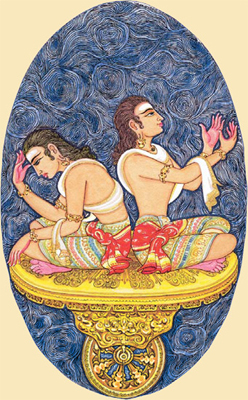
Ten Correct Concepts
ONE: Karma means act or deed.
Let’s begin with the word karma itself. What does it mean? Karma means “action” or “deed,” such as in the common phrase karma yoga, “union through action.” §
TWO: The law of karma is the law of cause and effect.
When we say “the law of karma,” we refer to the law of action and reaction, also called the law of cause and effect. This law states that what we sow we shall reap in this or future lives. Benevolent actions (punyakarma or sukarma) will bring loving reactions. Selfish, hateful acts (papakarma or kukarma) will bring suffering. Every action that we perform in life, every word we speak, even every thought that we think, has its reaction. §
THREE: Karma is just and self-governing.
The law of karma is a divine, self-governing system of justice that automatically creates the appropriate future experience in response to the current action. However, unlike the justice systems of a country, which only punish the misdeeds of those who are caught, tried and found guilty, karma punishes misdeeds and rewards good deeds whether they are known or not. For example, if a man robs a bank and is never caught, no punishment is received through man’s law. However, he will inevitably face the consequences of his crime through the law of karma. Similarly, the good deed of giving money regularly but anonymously to a charity will be rewarded, even though no one knows the giver’s name. §
FOUR: Karma is our teacher.
Through understanding the consequences of their actions, individuals sooner or later learn to refrain from committing a particular misdeed. Any good system of justice does not want repeat offenders. It wants individuals to understand the error of their ways and reform their behavior. You’ve heard Alexander Pope’s famous phrase that to err is human, to forgive is divine. Well, we can adapt his adage and say to err is human but to err only once is divine, meaning those who are striving to live a religious life are self-reflective and learn quickly from their mistakes. This is what we mean by saying “Karma is our teacher.” It teaches us to refine our behavior—hopefully sooner rather than later. One way to tell a young soul from an old soul is to observe how quickly he learns karma’s lessons in life. §
FIVE: We each have our individual karma.
Karma also refers to our individual karma that we carry from life to life, both the karma to be resolved in this life, and the karma to be resolved in a future life. To understand this better, let us reflect again on the criminal justice system. Justice is known for moving slowly. It can take a number of years before a convicted criminal receives his punishment. The law of karma is even slower. The consequences, or fruits of actions, known as karmaphala, may not come for a number of lifetimes. Thus, the karma we are born with is comprised of rewards and punishments from many past lives that have yet to manifest, and are yet to be resolved.§
SIX: There are three types of individual karma.
Our individual karma is of three types: sanchita, prarabdha and kriyamana. Sanchita is the sum total of past karmas yet to be resolved. Prarabdha is that portion of sanchita karma scheduled to be experienced in the present life, shaping its events and conditions, including the nature of our bodies, personal tendencies and associations. Kriyamana is karma you are presently creating. While some kriyamana karmas bear fruit in the current life, others are stored for future births. §
SEVEN: Astrology indicates the patterns of karma.
Prarabdha karma determines one’s time of birth, which dictates one’s astrology, which in turn delineates the individual life pattern by influencing the release of these karmas. Thus, an individual will experience certain astrological periods as difficult and other periods as auspicious and positive. Astrology does not dictate our karma, rather our karma determines our astrology, so understanding our horoscope helps us knowledgeably manage our karma as it arises to be faced.§
EIGHT: Karmas are either active or inactive.
Sanchita, prarabdha and kriyamana karmas can each be divided into two categories: arabdha, “begun” or “undertaken” karma that is sprouting; and anarabhda, “not commenced,” “dormant,” or seed karma. An analogy can be drawn to a garden in which a variety of seeds have been planted. Some types of plants will sprout in a few days, others will take weeks and still others lie dormant for months. Similarly, some of our karmas will manifest in the next few years, some toward life’s end and others in a future life. §
NINE: We create our own future.
Our actions in the present are creating what we will experience in the future, even in future lives. The point here is that when we think of karma, we tend to think of the past. We reflect upon the rewards and punishments from the past that are now manifesting and what we must have done to create them. However, we must also think about our future in this life and lives to come. Our actions in the present are influencing that future, making it pleasant or unpleasant. Therefore, before acting, a wise person reflects on that action’s karmic consequences and thereby consciously molds his future. §
TEN: Life is all about resolving karma.
The ultimate future to consider is liberation from the cycle of birth and death, samsara. As long as we have karmas to resolve, we will be reborn on Earth. Thus, individuals who are intent upon spiritual progress take the creation and resolution of karma quite seriously. Not only do they strive to act wisely in the present, they perform extra religious practices to rid themselves in this life of karmas that would normally only manifest in future lives. This is a profound practice performed by sagacious sannyasins especially.§
